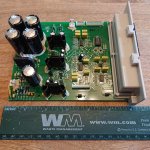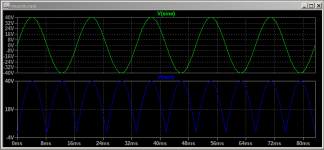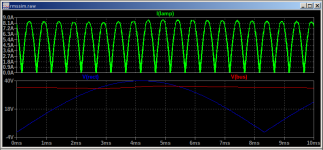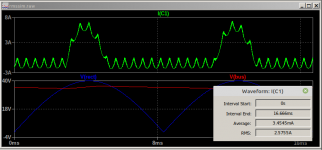Hello Folks,
This is my first post, and I am nearly a total n00b with this stuff, but I hope you can help me. I need to figure out some suitable caps to recap my Klipsch iFi amplifier power supply. It's a 200 watt class D amp inside the subwoofer box of a 2.1 channel desktop system. I'm attempting to attach a photo to this post. The original caps are Rifeking 4 x 4700uF 35v after the bridge and a Rifeking 4700uF 25v that goes to an external iPod dock and volume control module. All rated to 85 degrees C. All five of these are bulging/leaking.
I have ordered Nichicon FW series caps to replace these, and the physical dimensions of these, the capacitance, and voltage of these are the same as the old caps, but I cannot find any further specs on the old caps, and I am starting to worry if the Nichicon FW caps will be an appropriate replacement. I am struggling to understand things like ripple, ESR, etc. Should I be prioritizing Ripple, or ESR, or impedance, or lifespan or (?) of the replacement caps? Can I be confident that the FW series will be a good replacement or should I look to something else?
Best regards,
Jon
This is my first post, and I am nearly a total n00b with this stuff, but I hope you can help me. I need to figure out some suitable caps to recap my Klipsch iFi amplifier power supply. It's a 200 watt class D amp inside the subwoofer box of a 2.1 channel desktop system. I'm attempting to attach a photo to this post. The original caps are Rifeking 4 x 4700uF 35v after the bridge and a Rifeking 4700uF 25v that goes to an external iPod dock and volume control module. All rated to 85 degrees C. All five of these are bulging/leaking.
I have ordered Nichicon FW series caps to replace these, and the physical dimensions of these, the capacitance, and voltage of these are the same as the old caps, but I cannot find any further specs on the old caps, and I am starting to worry if the Nichicon FW caps will be an appropriate replacement. I am struggling to understand things like ripple, ESR, etc. Should I be prioritizing Ripple, or ESR, or impedance, or lifespan or (?) of the replacement caps? Can I be confident that the FW series will be a good replacement or should I look to something else?
Best regards,
Jon
Attachments
Based on your photo it is a linear supply, input bridge rectifier, and presumably supplied by a lump of iron transformer. As such things like ESR and total capacitance which can affect loop stability in a Switch Mode Power Supply is not a concern.
Rifeking crop up...
Badcaps Forums - Unknown Capacitor Brands
Rifeking, and Samwha are known crap.
It's reasonable to assume that your Nichicons will meet if not exceed the specifications of the originals even without knowing their specs.
The one to look at would be 100/120Hz ripple current rating but that would mean you would have to work out what that might be with your particular circuit but I would not be too bothered. Translate that as either I don't know how or my head does not need scratching at this moment in time.
Many, including me, would consider using 105C rated low ESR devices such as that that might be found in an SMPS if they are available in similar sized cans for longevity. I guess that assumes the unit is something you wish to keep and you like it.
Rifeking crop up...
Badcaps Forums - Unknown Capacitor Brands
Rifeking, and Samwha are known crap.
It's reasonable to assume that your Nichicons will meet if not exceed the specifications of the originals even without knowing their specs.
The one to look at would be 100/120Hz ripple current rating but that would mean you would have to work out what that might be with your particular circuit but I would not be too bothered. Translate that as either I don't know how or my head does not need scratching at this moment in time.
Many, including me, would consider using 105C rated low ESR devices such as that that might be found in an SMPS if they are available in similar sized cans for longevity. I guess that assumes the unit is something you wish to keep and you like it.
Last edited:
Oh.... I missed your note that it is a Class D amplifier.
I should add that you really really want to replace with low ESR 105C devices. A Class D amplifier draws discontinuous square wave current from its supply rails. That's big HF ripple current which will eat bog standard electrolytics in a short space of time.
I should add that you really really want to replace with low ESR 105C devices. A Class D amplifier draws discontinuous square wave current from its supply rails. That's big HF ripple current which will eat bog standard electrolytics in a short space of time.
Based on your photo it is a linear supply, input bridge rectifier, and presumably supplied by a lump of iron transformer. As such things like ESR and total capacitance which can affect loop stability in a Switch Mode Power Supply is not a concern.
Rifeking crop up...
Badcaps Forums - Unknown Capacitor Brands
Rifeking, and Samwha are known crap.
It's reasonable to assume that your Nichicons will meet if not exceed the specifications of the originals even without knowing their specs.
The one to look at would be 100/120Hz ripple current rating but that would mean you would have to work out what that might be with your particular circuit but I would not be too bothered. Translate that as either I don't know how or my head does not need scratching at this moment in time.
Many, including me, would consider using 105C rated low ESR devices such as that that might be found in an SMPS if they are available in similar sized cans for longevity. I guess that assumes the unit is something you wish to keep and you like it.
Hey, @MorbidFractal, thank you so much! It's a class D amp, and I thought that meant that this would be a switching power supply, but like I said, I'm a n00b. How can you tell that it is a linear power supply?
Yes, the transformer is a heavy toroidal coil
I think I found a spec sheet for the Rifeking cap on a website called paullinebarger.net/DS/Rifeking/ there is no HTML page, just a directory with spec sheets for Rifeking caps. I downloaded all the sheets for radial caps and the "GS" series was the only one that matched what I already know about the caps on my PCB. If I am correct, then the only difference in the specs are in a slight difference in ripple current as such:
Brand/uF/V/ripple
NichiconFW/4700/25/2360
NichiconFW/4700/35/2490
RifekingGS/4700/25/2160
RifekingGS/4700/35/2570
I assume this means I should be good to go? I am thinking that the lone 25v cap may be a subwoofer preamp cap, because the external control module features separate volume and subwoofer level controls. Does this sound right? There is a volume IC on the right side of the PCB in the picture above (white printing on it).
If I wanted better caps in this application than the FW series I have already picked out, what would you recommend from Digi-Key or Mouser?
dont worry those nichicon fw will work, if there is "square wave current" as morbidfractal says on bulk caps and there is no local high freq filtering, then pcb has problems with layout/schematics and no special electrolytics can solve that.
dont worry those nichicon fw will work, if there is "square wave current" as morbidfractal says on bulk caps and there is no local high freq filtering, then pcb has problems with layout/schematics and no special electrolytics can solve that.
Okay, now I am confused. Do I need to worry about operating temp and ESR because this is a class D amp or not? Also, will having a higher 120Hz ripple spec on the replacement caps risk adding noise to the audio?
Nichicon PS and PW series are 105C rated, have "low impedance" and will both fit in my application and have higher than original caps ripple at 120Hz (I excluded lines with lower 120Hz ripple).
~ Jon
Yes use 105 degrees AND low ESR stuff here. Pana FM is OK too. I would not use "audio grade" parts in this case.
Last edited:
Yes use 105 degrees AND low ESR stuff here. Pana FM is OK too. I would not use "audio grade" parts in this case.
I can't use Pana FM. I need 4700uF at 35V.
Is United Chemi-Con a good brand?
Also, could it introduce noise to use caps with a higher 120Hz ripple than stock? The ones I am looking at now have about 20-30% higher 120Hz ripple than the stock capacitors.
ARGHH Ignore me. (I see you have been advised to already 🙂).
For 200W the amplifier is going to be bridged. Effectively you only have to deal with the audio current. Even so for a 4 ohm load you would need a 40V supply. That's 28V RMS 28^2/4 = 196W. The RMS current would be 7A which is subject to derating.
I'll shut up. Take the advice of ToniToniToni.
For 200W the amplifier is going to be bridged. Effectively you only have to deal with the audio current. Even so for a 4 ohm load you would need a 40V supply. That's 28V RMS 28^2/4 = 196W. The RMS current would be 7A which is subject to derating.
I'll shut up. Take the advice of ToniToniToni.
For 200W the amplifier is going to be bridged. Effectively you only have to deal with the audio current. Even so for a 4 ohm load you would need a 40V supply. That's 28V RMS 28^2/4 = 196W. The RMS current would be 7A which is subject to derating.
Dear MorbidFractal,
I have no idea what any of that means! LOL I'll assume you are all in agreement then that the Nichicon FW series caps will be a good choice.
I'm still a bit confused about ripple though, and I am curious if I were to cancel my order for FW series caps and instead put in PW series caps that have a 25% higher 120Hz ripple than the stock caps, is there any possible drawback to this (noise in audio path, or something else)?
~ Jon
In terms of ripple current rating higher is better at any frequency. Klipsch claim 200W @ 35V which sounds iffy. The absolute voltage of your supply will set the maximum power output into any particular load.
The supply is subject to a ripple voltage. Your 60Hz sine mains gets rectified into a 120Hz...
Picture: V(SINE) is secondary of your transformer. V(RECT) is after the rectifier.
Your capacitors only get charged up when V(RECT) exceeds the voltage stored on them. This is one source of ripple current. That process also means that your DC bus to the amplifier has a ripple voltage on it.
Picture: I(DRECT) is the rectifier current V(RECT) is as before. V(BUS) is the DC supply to your amplifier. You can see that the capacitors are only charged up when the voltage from V(RECT) exceeds the V(BUS) voltage and discharges when it is below.
The peak I(DRECT) current is high, don't place too much value on the value it's a model, but the RMS is lower. Of more immediate concern is the ripple voltage, how much it sags in between charging.
If the bulk capacitance, total uF, is too low then the ripple becomes high and your amplifier will be driven into clip earlier. That affects the claimed rated power. As I suggest I don't think Klipsch are being honest or they are quoting funny numbers.
I(DRECT) is not the whole story as far as ripple current in the capacitors is concerned. On the other side of things the amplifier draws current to produce music.
Picture: I(IAMP) is what the amplifier is drawing from BUS. This is a 1KHz sine wave at the limit of clipping. If you look closely you can see the ripple voltage imposed on the peaks. When V(RECT) is above V(BUS) most of the amplifier demand will be from V(RECT) otherwise it is from the Capacitors.
As a result the current in the capacitors is a mix of two sources. One low frequency, Mains, and one high frequency, Audio.
Picture: This is the current in one, of the four, capacitors. It comprises the mains charging current and the amplifier music current, discharge so it is negative. There is also higher frequency current. That's the ripple current in the amplifier output filter inductor.
If you care then you have to account for the fact that these currents are at different frequencies and the ESR of the capacitor is different at those frequencies resulting in different losses. However...
In all cases everything gets complicated by the fact that in terms of RMS power music, by and large, can be treated as being 1/8th the power of its peak.
200 RMS Watts of Music is only 25 Watts RMS Average of Power. It is this sort of behaviour that allows you to derate certain specifications for components.
As a result Klipsh will likely have designed to a Ripple Voltage specification to achieve a claimed power without clipping and sort of said the ripple current looks OK. Sell It.
End result is that for you your chosen Capacitors are going to do the job and do it better than the originals.
Apologies for the added added confusion.
The supply is subject to a ripple voltage. Your 60Hz sine mains gets rectified into a 120Hz...
Picture: V(SINE) is secondary of your transformer. V(RECT) is after the rectifier.
Your capacitors only get charged up when V(RECT) exceeds the voltage stored on them. This is one source of ripple current. That process also means that your DC bus to the amplifier has a ripple voltage on it.
Picture: I(DRECT) is the rectifier current V(RECT) is as before. V(BUS) is the DC supply to your amplifier. You can see that the capacitors are only charged up when the voltage from V(RECT) exceeds the V(BUS) voltage and discharges when it is below.
The peak I(DRECT) current is high, don't place too much value on the value it's a model, but the RMS is lower. Of more immediate concern is the ripple voltage, how much it sags in between charging.
If the bulk capacitance, total uF, is too low then the ripple becomes high and your amplifier will be driven into clip earlier. That affects the claimed rated power. As I suggest I don't think Klipsch are being honest or they are quoting funny numbers.
I(DRECT) is not the whole story as far as ripple current in the capacitors is concerned. On the other side of things the amplifier draws current to produce music.
Picture: I(IAMP) is what the amplifier is drawing from BUS. This is a 1KHz sine wave at the limit of clipping. If you look closely you can see the ripple voltage imposed on the peaks. When V(RECT) is above V(BUS) most of the amplifier demand will be from V(RECT) otherwise it is from the Capacitors.
As a result the current in the capacitors is a mix of two sources. One low frequency, Mains, and one high frequency, Audio.
Picture: This is the current in one, of the four, capacitors. It comprises the mains charging current and the amplifier music current, discharge so it is negative. There is also higher frequency current. That's the ripple current in the amplifier output filter inductor.
If you care then you have to account for the fact that these currents are at different frequencies and the ESR of the capacitor is different at those frequencies resulting in different losses. However...
In all cases everything gets complicated by the fact that in terms of RMS power music, by and large, can be treated as being 1/8th the power of its peak.
200 RMS Watts of Music is only 25 Watts RMS Average of Power. It is this sort of behaviour that allows you to derate certain specifications for components.
As a result Klipsh will likely have designed to a Ripple Voltage specification to achieve a claimed power without clipping and sort of said the ripple current looks OK. Sell It.
End result is that for you your chosen Capacitors are going to do the job and do it better than the originals.
Apologies for the added added confusion.
Attachments
In terms of ripple current rating higher is better at any frequency. Klipsch claim 200W @ 35V which sounds iffy. The absolute voltage of your supply will set the maximum power output into any particular load.
Wow, MorbidFractal, thank you so much for all that detailed explanation!
Yes, Klipsch simply marketed this thing as a "200w system", but the subwoofer is rated at 100w and the satellites are rated at 50w each. The amp probably doesn't deliver that.
As for the rest of what you wrote, I think I followed about 50% of it. Is it possible that I am conflating ripple current ratings with ripple voltage, and it is this ripple voltage (not the ripple current rating of a capacitor) that has the potential to create "noise" in the audio path. The capacitor must simply have a ripple current rating high enough able to handle the ripple being delivered to it? Am I to further understand that that it is really impedance/ESR that influence the potential for ripple voltage noise, and not ripple current rating? Is it also true that lower impedance/ESR would naturally lead to higher ripple current ratings as impedance is inversely proportional to current?
Is it also true then, that though the FX series capacitors may work fine and noise-free in my application, that choosing the PW series capacitors may have some benefit in increased operating efficiency and lower operating temperature?
~ Jon
If it were mine, I would use the largest Panasonic FM, or FC that I could find that will fit on the board in that voltage, and not worry too much about the capacitance rating.
Nichicon PS is a similar part, if you are stuck on that brand, and there are probably many more that will have similar specs. These specs can be found in the data sheet for most models, esr, temp ratings, physical size...
Class D amplifiers aren’t the typical audio application, by the nature of their high speed action.
Nichicon PS is a similar part, if you are stuck on that brand, and there are probably many more that will have similar specs. These specs can be found in the data sheet for most models, esr, temp ratings, physical size...
Class D amplifiers aren’t the typical audio application, by the nature of their high speed action.
If it were mine, I would use the largest Panasonic FM, or FC that I could find that will fit on the board in that voltage, and not worry too much about the capacitance rating.
Nichicon PS is a similar part, if you are stuck on that brand, and there are probably many more that will have similar specs. These specs can be found in the data sheet for most models, esr, temp ratings, physical size...
Class D amplifiers aren’t the typical audio application, by the nature of their high speed action.
Thanks. Panasonic FC would fit at 3900uF, but I already ordered Nichicon PW (which exceed all the specs of the original capacitors, so I think I am good).
BTW, that should have been Nichicon FW, not FX in my post above this - I can't seem to edit it, but I want to make the correction for the record.
Last edited:
- Home
- Amplifiers
- Power Supplies
- Capcitors for Class D Amp Power Supply Recapping???




